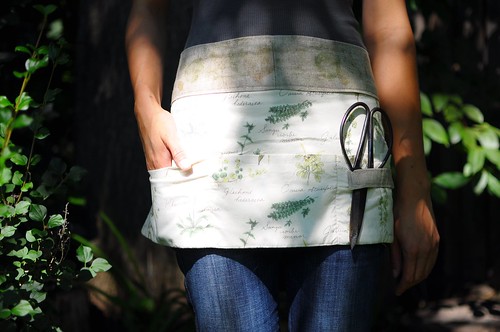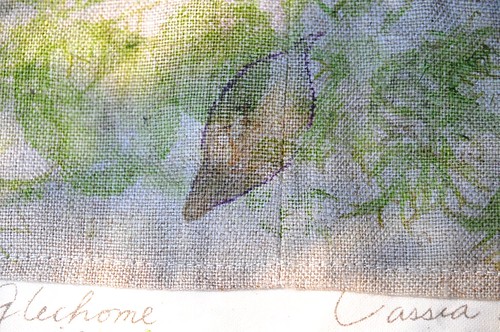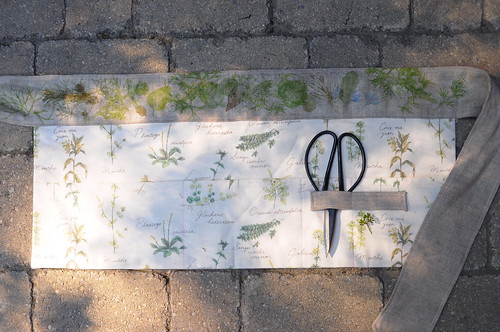HANDY APRON
I designed the Handy Apron shortly after opening the workroom. At the time, I was the only one working in the shop and often found myself trying to find my one tape measure or remember where my pair of scissors was. I decided to take a crack at creating my own utility apron that could double as a gardening apron or just a generally handy apron with pockets and loops.
I’ve made a few of these and love wearing them. All the little pockets are great to stash all kinds of things you might want to have quick access to. When I saw this French botanical fabric (the writing is in French, but the fabric is Japanese), I knew I needed to make myself a gardening apron. I used contrasting fabrics for the first time, choosing a plain linen for the ties and for the tool loops. When the apron was finished, I thought it would be fun to add some texture to the natural linen. During the India Flint workshop, India talked about a technique she would often do called hapa-zome. Essentially, you hammer or smash plant material (leaves or flowers) into fabric to create an imprint. I really wanted to try this simple technique out. I snipped some leaves from the garden and set about smashing them into the linen ties. Some things worked better than others, but I was amazed at the clarity of the images this technique left behind. When reading up on other people’s experiences with hapa-zome on the internet, I found that most people would layer the plant material in between two pieces of fabric before smashing. I used a metal hammer and carefully tapped directly onto the leaves that lay on my fabric, which was laid out on top of a piece of template plastic on top of patio stones. This is an incredibly satisfying process, as you can imagine.
To set the imprints, I just used my iron to steam the fabric. I’ve also read about using salt water to set the prints. To test the fastness, I threw the apron in the washer and dryer. There was a bit fading. I think it was mostly all the smashed plant material being washed away, but I quite like the faded look. This method is not super permanent, but apparently it can be extended by pre-mordanting the fabric and also by waiting as long as possible before washing it.
One note. I used organic cotton canvas as a sew-in interfacing inside the apron. This is something I’ve been using as a substitute for interfacing in my bags and other projects. I didn’t pre-wash the canvas before using it and it shrunk a fair amount when I washed the apron. I ended up taking part of the apron apart to adjust for the shrinkage. I hadn’t run into this problem before, since I don’t usually wash my bags. I will pre-wash the cotton canvas going forward, just in case.






15 Comments

JTS
August 6, 2010 at 1:37 pm

peanut
August 6, 2010 at 1:45 pm

michelle
August 6, 2010 at 2:15 pm

rosamaría
August 6, 2010 at 3:50 pm

Charity
August 7, 2010 at 1:09 am

Anna
August 7, 2010 at 10:04 am

Miss White Wall
August 7, 2010 at 11:22 am

melissa
August 7, 2010 at 12:23 pm

Katherine
August 7, 2010 at 2:14 pm

Tania
August 9, 2010 at 11:55 pm

tanya
August 13, 2010 at 7:29 am

Rashida
August 13, 2010 at 8:48 am

Alison
August 14, 2010 at 4:22 pm

Lorraine
September 22, 2010 at 6:47 pm
Herbal Holidays – More gifts you can make | Live for a Living
March 14, 2014 at 5:40 am
that is amazing!
I love your apron (and the hapa-zome – I’m going to have to try that). Did you write up this pattern for purchase at THe Workroom? It would be a perfect present for my sister the gardener (who was saying the other day that she really needs a little apron with good pockets for working around the house).
that is SO COOL karyn!
I really LOVE that apron! looks fantastic!!
LOVE the idea of smashing plant material into fabric – the apron is awesome!
love the apron and the print is just beautiful!
That is an awesome apron! I love the hapa-zome technique, I will definitely need to try that sometime soon.
karyn this is so beautiful! i love the fabric and the imprints!
I love this, Karyn! Also, it seems like a great project for frustrating days: smashing things (even lightly) could be especially therapeutic, and you’re left with something pretty at the end.
Wow, what a great technique, I love it! I just found and love your site – I’m starting to read through all the back entries – so many wonderful projects! Thank you for the inspiration!
this is the best apron style I’ve seen around. I hope to take this class soon!
Okay, this project just rocks my world, Karyn! SO cool! I love it!
Just lovely.
That is such a great technique & I love the apron .
[…] For the luxury bathers Cinnamon brown sugar scrub For the family table Scented herbal bowls For the gardener apron stamped with fresh herbs For the fridge Paper magnets with plant material For a home spa […]